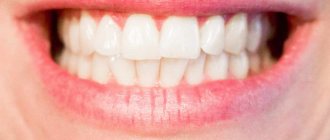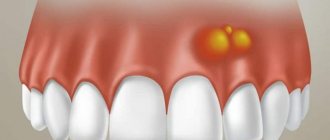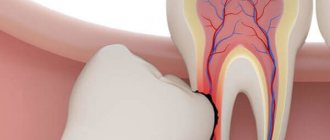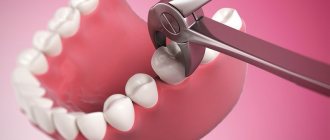Patients often face a situation where a wisdom tooth becomes ill, or we hear that someone will have their wisdom tooth removed. Let's take a closer look at this problem. What are wisdom teeth? About how problems of wisdom teeth are solved in family dentistry - in the article by the chief physician of the center Tsukor S.V.
This article will discuss one of the problems that arises with wisdom teeth and is most often encountered in the practice of dentists - asymptomatic diseases of the wisdom tooth.
Such diseases of the wisdom tooth occur without symptoms and harm the seventh tooth. The wisdom tooth does not bother the patient in any way, but the consequences of the disease and inflammation can appear at any time and bring a lot of trouble to the person.
A wisdom tooth that does not manifest itself in any way, does not bother or hurt, often does not attract the attention of a dentist. This happens, first of all, because the doctor in most cases is focused on the patient’s complaints. In some clinics, performing a comprehensive oral examination is not standard. In many dental centers, patients are not given a panoramic photo, which helps to identify hidden dental problems.
The Dial-Dent dental clinic practices a comprehensive examination of patients using the most modern diagnostic devices. This undoubtedly improves the quality of treatment, allows you to find problems hidden from the patient and begin treatment in a timely manner.
Let's consider 3 clinical cases on the topic “Removal of a wisdom tooth” from the practice of the chief dental physician S.V. Tsukor.
- Clinical case No. 1 Asymptomatic wisdom tooth - remove the 8th tooth, save the 7th tooth
- Clinical case No. 2 Removal of a wisdom tooth before implantation of the 6th tooth
- Clinical case No. 3 An incorrectly grown wisdom tooth harms the 7th tooth
Clinical case No. 1
Number of roots in human teeth
There can only be one dental crown, but the number of roots a tooth has depends on its location and purpose. The number of roots is also influenced by hereditary factors. It is possible to determine how many roots a tooth has only with the help of an x-ray. The inner part of the tooth (root) makes up about 70% of the entire tooth.
Factors influencing the number of roots:
- Location of the tooth.
- The purpose of the tooth, its functionality (chewing or frontal).
- Genetic predisposition.
- Patient's age and race. In the European race, the number of dental roots is very different from the Negroid and Mongoloid races.
Asymptomatic wisdom tooth - remove the 8th tooth, save the 7th tooth
A young man came to the Dial-Dent dental clinic to treat a tooth with caries. Dental treatment for caries was performed on the day of treatment. Traditionally, the patient was recommended (to assess the condition of the entire dental system) to undergo Alaverdov V.P. using modern digital diagnostic equipment.
After analyzing the image, specialists drew the patient’s attention to several serious problems (see photo below):
- The wisdom tooth on the lower left has partially erupted, as can be seen in the picture, but is tilted. A narrow gap has formed between the wisdom tooth and the 7th tooth. Food gets stuck in this gap, which first leads to bad breath, and later can lead to inflammation or gumboil.
- Using a panoramic photograph of the teeth, doctors were able to see a deep carious cavity on the seventh tooth.
What happens if you don't pay attention to a diseased wisdom tooth?
- Inflammation of the gums, swelling, gumboil.
- Pulpitis in the seventh tooth due to deep carious lesions. Only a panoramic photograph of the teeth will help determine what is causing the pain and inflammation in this case.
Asymptomatic wisdom tooth - solution to the problem
- Teeth cleaning. It is necessary to carry out a procedure to remove tartar and remove plaque. This is necessary in order to carry out wisdom tooth extraction in clean conditions. This approach significantly reduces the risk of inflammation after wisdom tooth removal.
- Wisdom tooth removal. In dental dentistry, the removal of wisdom teeth is performed by qualified maxillofacial surgeons Alaverdov V.P. and Yakimenko I.I. There is the necessary equipment and anesthesiologists to remove teeth under anesthesia.
- Healing of the gums after wisdom tooth removal usually lasts 2-3 weeks. After this, you can begin treatment and restoration of the 7th tooth. Without removing tooth 8, quality treatment of tooth 7 is impossible.
- Treatment of the 7th tooth. Note that it is extremely difficult to treat a distant tooth due to its location. For high-quality treatment, it is necessary to have high-quality equipment at the workplace and qualified assistance from a medical assistant. It should be added that it is not recommended to restore a tooth with a light-curing filling. The best restoration method in this case is a ceramic inlay.
The 8th tooth socket is covered with a special material
Advantages for patients of the treatment and diagnostic tactics offered by the Dial-Dent clinic:
- Comprehensive diagnostics - identifying hidden problems at an early stage.
- Saving the 7th tooth, the health of which is very important for the bite.
- Identifying a problem in the 7th tooth before the onset of predicted pulpitis allows you to save money on treatment, since pulpitis is more difficult to treat and therefore more expensive.
Clinical case No. 2
Teeth numbering system
Dentists have developed a system in which all teeth have their own serial number. The numbering system for the teeth of the lower and upper rows will not allow you to “get confused” in the teeth.
The first number is the incisors - the frontal teeth of the upper and lower rows. There are two teeth on each side (left and right): No. 1 - central, No. 2 - lateral, behind which there are fangs, numbered No. 3. The small molars have numbers 4 and 5.
All of the listed teeth have one cone-shaped root.
Teeth No. 6, 7, 8 - large molars have three roots, and tooth No. 6 of the lower row has one root, with the exception of tooth No. 8, which can have 3 or even 4 roots.
Should I get dentures for the 7th tooth?
This question, oddly enough, cannot be called rarely asked. This is probably due to the fact that the “seventh” teeth can be classified as practically the most distant ones and their absence is not noticeable to people around them in everyday life. However, this is by no means the main purpose of teeth - it is the distant chewing teeth that play one of the key roles in the process of chewing food, on which the quality of digestion largely depends. And already, at least based on this, it is undoubtedly better to perform dental prosthetics.
However, let’s try to answer this question based on several extremely important aspects:
- If at least one chewing tooth is missing in the jaw, then the chewing load can no longer be distributed evenly, which means that sooner or later, problems with other teeth will inevitably begin;
- Our body is a perfect mechanism in which everything is interdependent and interconnected. This also applies to teeth: one of the features of our jaw is that the antagonist tooth (the tooth that is located clearly opposite in the upper/lower jaw) will be subject to the possibility of loss after a certain period of time. Since it no longer has support, it will begin to move forward, become loose, and may fall out;
- Digestive problems due to insufficient chewing of food are a very common case in people whose jaws lack the teeth necessary for chewing food.
These are, perhaps, the main factors that prove that dental prosthetics , which we need for chewing food, is a necessity for the health of the oral cavity and the body as a whole.
The main ways by which prosthetics can be made for “seventh” teeth in their absence are:
- Prosthetics with a bridge. This scheme is possible if you have adjacent teeth preserved in your mouth - that is, the sixth and eighth. They will serve as a support for the prosthesis. The disadvantage of the described prosthetic option is the need to grind down these very adjacent teeth - this cannot be avoided, since it is impossible to secure the prosthesis (bridge) otherwise;
- Dental implantation. Implantation of an artificial tooth root is the most progressive method of prosthetics for tooth loss and does not in any way affect neighboring teeth. After the implants have taken root, a crown .
It should be noted that dental implantation for prosthetics of the “seventh” tooth will be the most effective, harmless to other teeth, durable and reliable option. This is due to the fact that the service life of bridges is, on average, several years. While implants, if all recommendations are followed and proper oral care is taken, can last for the rest of your life.
Share on social media networks:
Rating 0.00 [0 Vote(s)]
How many canals are there in teeth?
The number of tooth canals does not always coincide with the number of roots. The number of channels can only be determined using x-rays. The upper incisors usually have two or three canals. Some teeth have only one canal, which branches into two parts.
Number of canals in teeth:
- Upper Lower four – 1, less often 2 channels;
- Upper second – 1, less often 2 and even 3 channels;
- Bottom five – one channel;
- Upper first molar 3, 4 canals;
- Lower first molar – 3, less often 2 canals;
- Upper and lower seven – 3, 4 channels.
Removal of a wisdom tooth before implantation of the 6th tooth
The patient went to the Dial-Dent clinic to see dentist S.V. Tsukor. with the desire to carry out prosthetic replacement of one missing tooth in the jaw.
The patient was offered implantation to replace 1 missing tooth. During diagnosis and preparation for dental implantation, the patient was given a panoramic image, which showed the presence of a hidden problem - a wisdom tooth. The treatment plan was changed: first, the patient had to remove the wisdom tooth, then treat the 7th tooth, and only then proceed with dental implantation.
In this case, correct diagnosis (panoramic image of the teeth) helped specialists correctly plan treatment and dental implantation.
Situation at the time of application
Clinical case No. 3
Possible complications after tooth extraction
Complications can appear during surgery, as well as after it, and can be local or general. General: fainting, rarely – shock. Their cause is the patient’s psycho-emotional stress, sometimes pain due to poor-quality anesthesia.
Local complications:
- Fracture of the tooth being removed (crown or root);
- Dislocation or fracture of a nearby tooth;
- Trauma to the soft tissues of the oral cavity;
- Dislocation or fracture of the jaw;
- Perforation of the bottom of the paranasal sinus;
- Pushing the tooth root into the maxillary sinus;
- Bleeding;
- Alveolitis.
The classic method of installing sevens implants
A two-stage protocol involves introducing a two-part titanium root into the bone (separate intraosseous and external parts) using a patchwork method, waiting for its engraftment, followed by prosthetics. The classic method is implemented when there is a sufficient amount of bone tissue. If the alveolar ridge in the area of the former seven is significantly atrophied, osteoplasty operations are resorted to. The bone is built up with artificial material, implants are installed simultaneously or after the material has engrafted.
Pros and cons of the classical method:
| Advantages | Flaws |
| extensive experience in implantology; | long implementation periods; |
| predicted result; | wearing removable dentures for the period of osseointegration; |
| formation of a beautiful gingival contour; | the need to build up bone when it is insufficient. |
| possibility of using implants from various manufacturers; | |
| the ability to eliminate defects in a row of any length. |
In appropriate clinical situations, it is possible to use other treatment regimens—simultaneous or single-stage implantation.
Dystropic tooth: indications for removal
A tooth with an incorrect location in the dentition relative to its neighbors is called dystrophic. It can take the place of another, spontaneously turn, change the angle of growth, which significantly interferes with neighboring teeth and leads to the formation of a malocclusion.
Indications for extraction of a dystrophic tooth are:
- swelling of the gums and pain;
- numbness of the face due to damage to nerve endings;
- pronounced curvature of adjacent teeth;
- periodontitis or chronic pulpitis;
- when, due to a problem tooth, it is impossible to perform prosthetics;
- if a dystrophic tooth is the cause of periostitis or osteomelitis.
The removal process itself is similar to the procedure for removing an impacted tooth.
Recommendations after removal
Regardless of the method by which the tooth was removed, in the first 2 days the patient must observe a special diet, activity and hygiene. This is necessary to preserve the blood clot in the wound, which helps maintain the sterility of bone tissue and promotes its regeneration.
In the first 48 hours after removal you cannot:
|
Failure to comply with these recommendations most often causes the clot to fall out of the socket and the development of alveolitis or bleeding.
After tooth extraction it is recommended:
- make oral baths from chamomile and sage decoctions (the decoction prepared according to the instructions is taken into the mouth and held there for 10 minutes, without rinsing or moving the tongue) 2-3 times a day;
- take non-steroidal anti-inflammatory drugs (especially after atypical removal, when the tissue is severely damaged and swelling occurs) - nimesulide, diclofenac sodium, ibuprofen, paracetamol, etc. (it is important that the medicine does not reduce blood clotting).
Sometimes patients need preliminary preparation for removal. People taking aspirin and other medications that impair blood clotting should stop taking them a week before the procedure. For those who suffer from increased excitability and anxiety, you can start taking valerian or motherwort 1-2 weeks before removal, having previously agreed with your dentist and your therapist.
Even if the removal was painless and quick, you should not ignore the doctor’s advice. The right approach to rehabilitation will help you avoid complications and recover faster.
Are you planning to restore a tooth with a CEREC inlay?
Always at your service - Sergey Samsakov, orthopedic dentist with more than 10 years of successful experience, Moscow. Expert in 3D digital smile modeling, dental inlays and dental modules, veneers and digital CEREC technology.
Patients come to me from all over Russia:
Price
- Primary appointment (examination, consultation) with a dentist (special offer) 100001
For free
Promotion
- Dental prosthetics using an implant with a temporary crown using the laboratory method (PMMA) 152006
7 500 ₽
- Simple tooth extraction 160001
1 900 ₽
- SGS implant + turnkey crown
24 900 ₽
Promotion
- Osstem implant + turnkey zirconium crown
29 900 ₽
Promotion
- Astra Tech implant + turnkey zirconium crown
59 900 ₽
Promotion
- Nobel implant + turnkey zirconium crown
59 900 ₽
Promotion
- Straumann implant + turnkey zirconium crown
59 900 ₽
Promotion
Implantation of the seventh tooth involves inserting an implant into the jaw and fixing an artificial crown on it. The method ensures complete restoration of the functions of the seven, but is associated with some risks. This is a surgical operation, with preparation and a rehabilitation period of 3-4 months. To replace the 7th lower or upper tooth, a classic two-stage treatment protocol is suitable, the implementation of which may require bone tissue augmentation. If the protocol is followed correctly, the patient will receive a tooth that matches the natural one.











